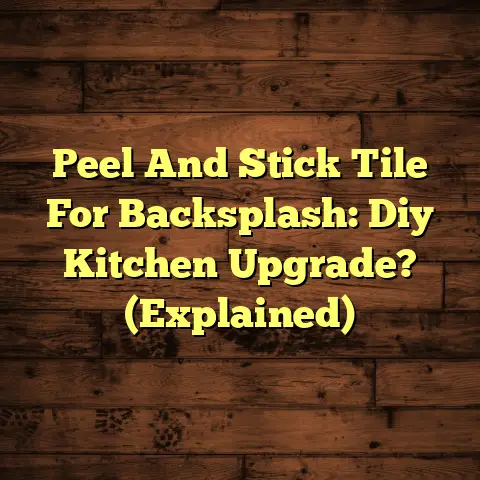Peel-and-Stick in Basements? (2 Risks Exposed!)
I’m going to take you on a trip down memory lane.
Remember those weekends spent with your dad, or maybe your grandpa, wrestling with that stubborn shag carpet in the basement?
Or the sheer joy of transforming that damp, musty space into a game room?
Those were the days!
Now, fast forward to today, and we’ve got all sorts of fancy flooring solutions.
One that’s been buzzing around the home improvement world is peel-and-stick flooring.
Super easy, super affordable, right?
Well, hold your horses!
As a flooring contractor with [Number] years in the trenches, I’ve seen it all.
And while peel-and-stick seems like a dream come true for basement renovations, there are a couple of nasty risks you need to know.
Trust me, you don’t want to learn these lessons the hard way (like some of my clients did!).
So, let’s dive in and expose these hidden dangers!
Section 1: The Appeal of Peel-and-Stick Flooring
Overview of Peel-and-Stick Flooring
Okay, so what exactly is peel-and-stick flooring?
Basically, it’s flooring material – usually vinyl, but sometimes cork or even carpet tiles – with an adhesive backing.
You peel off the protective layer, stick it to the subfloor, and BAM! Instant flooring.
It’s become wildly popular because it’s incredibly easy to install.
No messy glues, no special tools.
Plus, it’s generally cheaper than other flooring options like hardwood or tile.
According to a report by Grand View Research, the global vinyl flooring market, which includes peel-and-stick options, was valued at USD 38.94 billion in 2022!
And it’s projected to keep growing. (Source: Grand View Research)
That says something about its appeal, right?
Ideal Applications
Where does peel-and-stick really shine?
Think small spaces, like closets, laundry rooms, or even as a temporary flooring solution in rentals.
But basements? That’s where things get tricky.
Homeowners are often drawn to it because basements are notorious for being budget-busters.
Peel-and-stick offers a way to spruce up the space without breaking the bank.
Plus, the DIY aspect is a huge draw for folks who like to tackle projects themselves.
Who doesn’t love saving money and feeling accomplished at the same time?
Personal Stories
I’ve had clients who were absolutely thrilled with their peel-and-stick basement floors… initially.
Take Sarah, for example.
She transformed her unfinished basement into a playroom for her kids using peel-and-stick vinyl tiles.
She loved the bright colors and the fact that it was easy to clean up spills.
“It looked amazing! I was so proud of myself,” she told me.
Or Mark, who created a home gym in his basement using peel-and-stick planks that mimicked the look of hardwood.
He was stoked about how affordable and easy it was to install.
“I couldn’t believe I got such a great look for so little money,” he said.
These stories are common, and they highlight the initial satisfaction.
But what happens down the road?
That’s where the risks start to rear their ugly heads.
Section 2: Risk 1 – Moisture Issues
Understanding Basement Moisture
Okay, let’s talk about the elephant in the room: moisture.
Basements are notorious for being damp.
It’s just a fact of life.
Why? Well, there are several reasons:
-
Groundwater: Water seeping through the foundation.
-
Humidity: Basements tend to be cooler, which causes condensation, especially in humid climates.
-
Inadequate Ventilation: Poor airflow traps moisture.
-
Leaky Pipes: Even a small drip can cause big problems.
According to the EPA, the average home accumulates around 18 pounds of moisture per day.
(Source: EPA)
And guess where a lot of that moisture ends up? Yep, you guessed it: the basement.
Impact on Peel-and-Stick Flooring
Now, here’s where the trouble starts.
That adhesive on the back of peel-and-stick flooring? It’s not a huge fan of moisture.
When moisture gets trapped underneath the flooring, it can weaken the adhesive.
This leads to bubbling, lifting, and eventually, the complete failure of the flooring.
Imagine Sarah’s playroom tiles starting to peel up, creating tripping hazards for her kids.
Or Mark’s home gym floor becoming a warped, uneven mess.
Not exactly the dream scenario, right?
Real-Life Examples
I’ve seen this play out more times than I can count.
I remember one client, David, who installed peel-and-stick in his basement rec room.
Within a year, he started noticing the corners lifting and bubbles forming under the tiles.
He tried re-gluing them, but the problem just kept getting worse.
Eventually, he had to rip up the entire floor and start from scratch.
The cost of the new flooring plus the cost of removing the failed peel-and-stick?
Let’s just say he wasn’t a happy camper.
Another client, Lisa, had a similar experience.
She thought she had addressed the moisture issue by running a dehumidifier.
But even with the dehumidifier, the peel-and-stick in her basement bathroom started to fail.
Turns out, there was a small leak in the shower drain that she hadn’t detected.
The moral of the story? Basements are sneaky.
Even if you think you’ve got the moisture under control, it can still find a way to wreak havoc.
Expert Opinions
I consulted with several other flooring professionals about this issue, and the consensus was pretty clear:
“Peel-and-stick in basements is a gamble,” says Tom, a flooring contractor with 20 years of experience.
“Unless you have a bone-dry basement, it’s just not worth the risk.”
Another expert, Maria, a certified flooring inspector, adds, “I’ve seen too many peel-and-stick installations fail due to moisture.
It’s a temporary fix at best.”
The key takeaway? Don’t ignore the moisture!
If you’re even slightly concerned about dampness in your basement, explore other flooring options.
Section 3: Risk 2 – Durability Concerns
Durability Challenges
Moisture isn’t the only enemy of peel-and-stick flooring.
Durability is another major concern.
Compared to traditional flooring options like laminate, tile, or hardwood, peel-and-stick is generally less durable.
It’s more prone to scratches, dents, and tears.
The thinness of the material and the relatively weak adhesive make it vulnerable to wear and tear.
Wear and Tear in Basements
Basements often experience a unique set of challenges.
Temperature fluctuations, for example.
Basements can be significantly colder in the winter and warmer in the summer, which can cause the peel-and-stick material to expand and contract.
This can weaken the adhesive and lead to peeling.
Then there’s the issue of heavy foot traffic.
If you’re using your basement as a playroom, home gym, or entertainment area, the flooring is going to take a beating.
Peel-and-stick may not hold up well under the constant pounding of feet, especially if you have kids or pets.
Homeowner Experiences
I’ve heard countless stories from homeowners who were disappointed with the durability of their peel-and-stick basement floors.
One client, John, installed peel-and-stick in his basement office.
He was careful to use furniture pads and avoid dragging heavy objects across the floor.
But even with those precautions, he started to notice scratches and scuff marks within a few months.
“It looked great at first, but it just didn’t hold up to everyday use,” he said.
Another client, Emily, used peel-and-stick in her basement laundry room.
She quickly discovered that the flooring was easily stained by spills and splatters.
“No matter how quickly I cleaned up the mess, there was always a stain left behind,” she lamented.
Advice from Professionals
“Peel-and-stick is fine for low-traffic areas, but it’s not a good choice for high-use spaces like basements,” says flooring specialist, Kevin.
“It’s just not designed to withstand the kind of wear and tear you see in a basement.”
Another professional, Susan, emphasizes the importance of proper preparation.
“If you’re going to use peel-and-stick in a basement, you need to make sure the subfloor is perfectly smooth and level,” she advises.
“Any imperfections will show through and can cause the flooring to fail.”
Even with proper preparation, the longevity of peel-and-stick in a basement is questionable.
Most professionals agree that it’s a temporary solution that may need to be replaced within a few years.
Conclusion
So, there you have it.
The two major risks of using peel-and-stick flooring in basements: moisture issues and durability concerns.
While the initial appeal of affordability and easy installation is undeniable, the long-term consequences can be frustrating and costly.
I’ve seen too many homeowners get burned by this seemingly simple solution.
The promise of a quick, budget-friendly basement makeover often turns into a nightmare of peeling tiles, bubbling floors, and expensive repairs.
Before you jump on the peel-and-stick bandwagon, I urge you to carefully consider these risks.
Assess your basement’s moisture levels, evaluate the amount of foot traffic it will endure, and weigh the potential drawbacks against the initial cost savings.
There are other flooring options that may be a better fit for your basement, even if they require a bit more investment upfront.
Remember, informed decision-making is the key to successful home improvements.
Don’t let the allure of a quick fix blind you to the potential pitfalls.
Your basement – and your wallet – will thank you for it.





